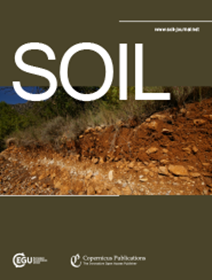特拉普内尔的赞比亚上山谷土壤:对地貌学、土壤学、生态学和土地利用的综合理解
IF 5.8
2区 农林科学
Q1 SOIL SCIENCE
引用次数: 0
摘要
摘要。20世纪30年代,在科林·g·特拉普内尔(Colin G. Trapnell)的领导下,北罗得西亚(现为赞比亚)的生态调查是一项开创性的工作,通过深入的实地观察,将土壤、植被和农业实践联系起来。在这篇文章中,我们研究了在Kafue平原周围的上山谷地区和邻近高原的早期调查活动,在那里,Trapnell认识到正常侵蚀的地貌过程如何产生具有相关植被群落的独特土壤和相当大的作物生产潜力。我们考虑特拉普内尔的实地考察方法如何使他对土壤条件如何限制赞比亚环境中的农业有了特别的见解;传统实践的适应价值;以及随着社区的迁移和对社会、经济和环境变化的反应,这些城市是如何发展起来的。我们认为特拉普内尔的工作是创新的,必须将他的理解与所谓的生态发展理论区分开来。密切关注特拉普内尔的经历可以为理解非洲土壤的土著知识及其农业潜力的现代努力提供信息。本文章由计算机程序翻译,如有差异,请以英文原文为准。
Trapnell's Upper Valley soils of Zambia: the production of an integrated understanding of geomorphology, pedology, ecology, and land use
Abstract. The Ecological Survey of Northern Rhodesia (now Zambia), undertaken in the 1930s under the leadership of Colin G. Trapnell, was a seminal exercise to relate soil, vegetation, and agricultural practices through intensive field observation. In this article, we examine early activities of the survey in the Upper Valley region around the Kafue Flats and the neighbouring plateau, where Trapnell recognized how geomorphological processes of normal erosion gave rise to distinctive soils with associated vegetation communities and considerable potential for crop production. We consider how Trapnell's approach to fieldwork gave him a particular insight into how soil conditions constrained agriculture in the Zambian environment; the adaptive value of traditional practices; and how these were developed as communities moved and responded to social, economic, and environmental change. We argue that Trapnell's work was innovative and that distinctions must be drawn between his understanding and what has been called the ecological theory of development. Close attention to Trapnell's experience could inform modern efforts to understand indigenous knowledge of African soils and their agricultural potential.
求助全文
通过发布文献求助,成功后即可免费获取论文全文。
去求助
来源期刊

Soil
Agricultural and Biological Sciences-Soil Science
CiteScore
10.80
自引率
2.90%
发文量
44
审稿时长
30 weeks
期刊介绍:
SOIL is an international scientific journal dedicated to the publication and discussion of high-quality research in the field of soil system sciences.
SOIL is at the interface between the atmosphere, lithosphere, hydrosphere, and biosphere. SOIL publishes scientific research that contributes to understanding the soil system and its interaction with humans and the entire Earth system. The scope of the journal includes all topics that fall within the study of soil science as a discipline, with an emphasis on studies that integrate soil science with other sciences (hydrology, agronomy, socio-economics, health sciences, atmospheric sciences, etc.).
 求助内容:
求助内容: 应助结果提醒方式:
应助结果提醒方式:


